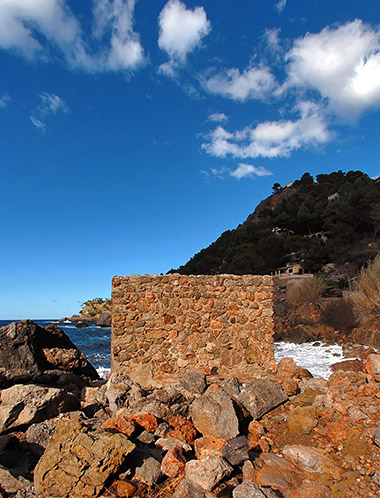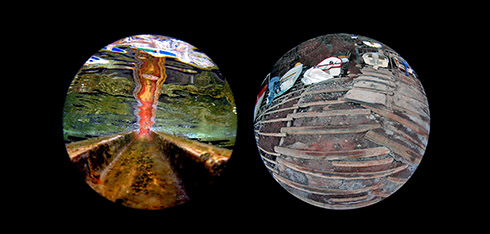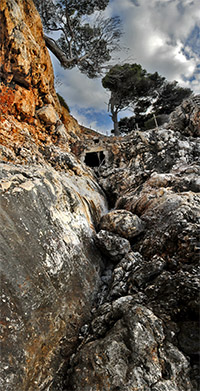Boathouses and boat ramps
The Serra de Tramuntana's coastline is very rugged and hard to reach. With the evident exceptions of some well-known harbours (Port de Sóller and Andratx), it is not easy to put out to sea from different points along the coast.
Boathouses can be found throughout Mallorca. These little seashore buildings were used to store boats, fishing tackle and all the utensils needed by fishermen. They can be seen all along the Mallorcan coast and, in each area, their design has been adapted to the local surroundings and closest available building materials. Along the Serra de Tramuntana coast, they stand out for their specific characteristics, precisely because of the coast's irregularity, inaccessibility, and its virulent sea storms, particularly when the wind blows from the northwest or north, in which case there can be authentic gales.

Boathouses offer just the right environmental conditions and level of humidity to conserve wooden boats
Boathouses are stone constructions, often with a vaulted roof. Sometimes a natural cavity was taken advantage of to build them or else the bottom of the boathouse was even excavated into the rock. The entrance, facing the sea, is normally barred by a gate instead of a door, because this makes boathouses perfect for storing boats, particularly wooden ones. Firstly, the building itself protects the boats from the weather, particularly from sunlight, which can be truly lethal for the wood of Mallorcan llaüts (small lateen-rigged boats). Secondly, proximity to the sea and good ventilation, thanks to the gate, both ensure just the right level of humidity for the boats' conservation.
A fundamental complementary feature of a boathouse is a boat ramp to get the vessel into and out of the sea from and to the boathouse. Boat ramps often have strips of wood fixed across them, parallel to the sea and perpendicular to the boat, which the vessel slides across. This is why boat ramps are also locally known as llenegadors (sliders). On other occasions, the wooden strips are moveable and cover the whole ramp, sometimes resting on blocks called escales. In all cases, the wood is well greased to help the boats slide across them.
Additionally, llaüts along the Tramuntana coast have escoes. These are sidepieces parallel to the keel, which keep the boat upright when it is out of the water or being launched into the sea.

The boathouses that abound all along the north coast are varied in type and well worth remembering, like Son Beltran boathouse in the municipality of Deià, between Deià cove and Llucalcari. It has to be one of the oldest, dating back to the 18th century, while most are from the 19th and early 20th centuries, although boathouses are documented as existing in the 15th century. It is made of stone and, in the middle of the lintel above the entrance, there is a shield bearing the anagram of Jesus. Nearby, in Llucalcari, En Mider boathouse can be found, with a boat ramp and small dwelling. En Jeroni boathouse is also worth visiting, even though it is a bit further away in Alconàsser.
The boathouses of Port des Canonge are probably the best known. On the beach, there are 27 boathouses of very different types. The oldest is Ca l'Arròs, dating back to the 1930s, while the most modern was made in the 1970s. Even so, we know that in the 19th century boats were brought ashore there. What is most interesting about Port des Canonge is the fact that, in this hamlet in the municipality of Banyalbufar, historically inhabited by folk from Esporles, boathouses are not known by the usual name of escars but as alcoves. This word is probably of Valencian origin, according to geographer Onofre Rullan.
"Senyor Joan" or Sa Costera boathouse is one of the hardest to reach. It stands under the houses of Sa Costera in the muncipality of Escorca. An interesting feature is its sandstone arch, probably from a sandstone quarry close by.
Good examples of boathouses can also be found at S'Estaca, in Valldemossa. They are very old, made by the professional fishermen who used this hamlet as a base for their fishing activities. The group of boathouses with their boat ramps lend the hamlet a truly magical charm, making it well worth your while to walk across from Port de Valldemossa (where you can also see boathouses, probably the most widely painted by artists). The above are just a few examples of boathouses, but many others can be found in lots of places along the coast. All of them have something that makes them unique and all have a tale to tell. Let's not forget that and let's not forget them.
Text by Bartomeu Homar
Translated by Rachel Waters
Did you know that...
The Consell de Mallorca has currently made 62 boathouses in Mallorca listed buildings, concentrated in the municipalities of Santanyí (44), Llucmajor (11) and Campos (7). The Serra de Tramuntana is also benefitting from this conservationist initiative, since a few months ago steps were taken to declare the boathouses of Port des Canonge listed buildings. Additionally, last July the Mallorcan Committee for Spatial and Urban Planning and Historic Heritage set proceedings in motion to declare En Fargas or Des Durais boathouse in Cala Barques (Cala de Sant Vicenç, in the municipality of Pollença) a listed building.
Suggested walk

Numerous different outings or walks can be made to get to know the Serra de Tramuntana's boathouses. We propose a relatively well-known route, suitable for all kinds of people, along Camí dels Pintors. Leave Deià cove along this path walking in an east/north-easterly direction. The path takes you to Llucalcari, but it gives you the chance to see some fascinating boathouses, like Son Beltran boathouse, mentioned above. In Llucalcari, you can see En Mider boathouse. If you want to carry on to En Jeroni boathouse in Alconàsser, bear in mind that the walk will be quite a lot longer and you will need some experience in direction finding and walking in the mountains.




